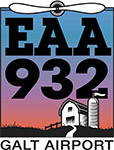One of the most rewarding experiences for a private pilot is being able to share the joy of flying with friends, family members, and other non-pilot people. However, our passengers can easily distract our attention from our flying duties, especially those that are not familiar with flying in general aviation airplanes.
Examples of common distractions would be passenger sickness, anxiety or simply an excessive number of questions. One way to minimize distractions in the air is to plan ahead and prepare for any eventuality before you begin the flight.
Anxiety
If your passengers have never been in a small airplane before it is a great idea to let them know ahead of time what to expect during the flight. We pilots are used to it, but takeoffs and landings especially can be quite nerve-wracking for first time passengers and they might react unpredictably.
Consider putting your most anxious passengers in the back seat, but if you allow them to sit up front, show them what they can safely grab onto, such as arm rests or the seat cushion. Anything except the yoke!
Always consider the comfort of your passengers and if you anticipate any level of turbulence or gusty winds it is best to postpone the flight. I have personally met many would-be-pilots who were deterred from flying forever by a first flight with an enthusiastic pilot friend in inclement weather conditions.
Sickness
Regularly check in with your passengers during the flight to look for signs of sickness or anxiety. Adjust the environmental controls for your passenger’s comfort and show them how to use the air vents. I highly recommend carrying airsickness bags and making those readily accessible to each passenger. Take note that some people may experience hypoxia even at lower altitudes depending on their medical history and medications so be on the lookout for early symptoms of oxygen deprivation.
Questions
Begin with taking the time to answer your passengers’ questions before the flight because the more you explain on the ground the fewer concerns they will have in the air.
Brief your passengers on the concept of a “sterile cockpit” and set expectations that allow you to fully concentrate on flying during the takeoff/departure climb and approach/landing phases of the flight.
In cruise, to help your passengers enjoy the experience you can point out landmarks they might never have seen from the air, explain how the airplane works and answer any questions they have.
Preflight Briefing
Before each flight, always conduct a thorough passenger safety briefing that includes items such as latching and unlatching the door(s), adjusting the seats and seatbelts, the location and operation of safety equipment and making sure their headset is fitted correctly. Remember that it is your duty as a pilot to brief your passengers on the operation of seatbelts and shoulder harnesses and to ensure they keep them fastened at a minimum during taxi, takeoff, and landing.
If there is a door on the passenger side, carefully check that is properly latched before you start the engine. A partially open door, while not a significant problem in itself, can be a terrifying problem for passengers who then become a major distraction for the pilot.
It is also a good idea to instruct your passengers to keep their hands and feet away from the controls and not to touch anything unless they have your permission.
With a little planning and effort before the flight you can hopefully avoid any major distractions in the air and ensure the experience is fun for everyone.
Beth Rehm, CFII

